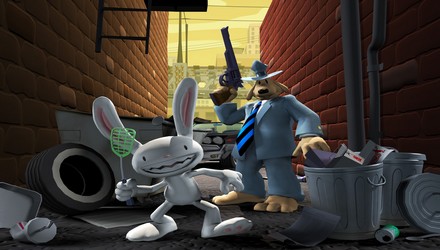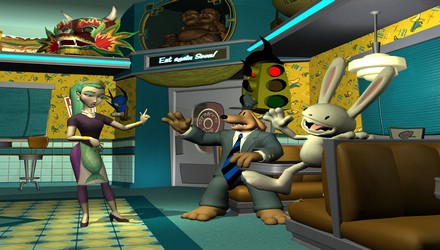Reviews
Review: Sam and Max Season 3 Special
June 22, 2010, Author: Ray Willmott
Sam and Max is one of the zaniest franchises you will ever experience. Their off the wall humour and nonchalant policing style has garnered the attention of fans all over the World, taking Steve Purcell’s smartly dressed dog and naked lagamorph from the pages of a comic book into a digitised gaming World, first in the hands of Lucasarts and now in the palms of Telltale Games. Season 3, The Devil’s Playhouse, follows on from Sam and Max Save the World and Sam and Max Beyond Time and Space, once again featuring the eccentric protagonists and a slew of memorable cast members such as Harry the Moleman, Abe Lincoln’s head and Momma Bosco. You can read more about Sam and Max Save the World right here. For now though, this article will focus on Season 3 and the new innovations and adventure Telltale have brought to their headline franchise.
Is this season Telltale’s finest hour? Read on to find out more…
Disclaimer: Please be advised that some spoilers are contained throughout these reviews and so it is advised that you play these episodes in order so as not to ruin your experience with the story. Thanks.

If you’ve ever played a Sam and Max game before, just playing the very opening of The Penal Zone, you’ll notice the difference straight away. The game is introduced by a narrator and seems to have adopted a much darker undertone than before. Certainly, the humour is as deranged and depraved as before, but there’s something malicious about the peril the characters are up against. This really does appear to be the Devil’s Playhouse and you’re stuck right in the middle of it.
The story begins with both Sam and Max stuck together in a prison cell on an oversized gorilla’s spaceship. Yep, it’s as zany as it sounds. Both dog and rabbity-thing seem to have been caught up in a nefarious plot and all their hopes seem to hinge on a mole that cannot verbally communicate being kept behind a glass window in the adjacent cell and a piece of clay. As you’ll soon find out, the game actually starts right in the middle of the story and so the narrative structure of the episode will see the player take part in the events leading up to its ‘prologue’. This may seem confusing at first but is a brilliant way for Telltale to introduce the new features to Sam and Max, which I’ll detail a bit later on in this review.
The first thing you’re liable to notice is that the graphics seem greatly improved from previous seasons, with facial expressions playing a much more predominant role in character interaction and communication with the player than ever before. It seems Telltale have used the animations set out in the Wallace and Gromit series of games (whereby Gromit’s sole interaction with the player comes from aforementioned facial animations) and use that to great effect to add even more emphasis on the hilarity and insanity of the franchise. Max will frown when confused, Sam will show disbelief and bafflement at the outrageous comments that spew from his partner’s mouth, but both can still look utterly deadpan and serious when necessary as and when needed. There seems to be richer landscapes, more variety in set pieces, from spaceships to underground sewers, and as never before, the environments seem more three-dimensional when following the players movements, which can even serve as aid as to where the player needs to go next to further their adventure.

Back on the beat
In my eyes, those who’ve never had the chance to play Save the World and Beyond Time and Space, may feel a little overwhelmed by the games unique sense of humour (such as a giant stone head of Abraham Lincoln having a relationship with Sybil, a woman who changes her careers quicker than her knickers), and confused as to what relevance the sub-cast of characters have to the Freelance Police, however, Telltale have structured the story in such a way that it also feels as if the series is being rebooted for a fresh audience, only giving some minor references to previous events in the other eleven episodes. Essentially, you’ll still be able to keep up with the narrative, as each episode is a self-contained story, but it is part of one large story-arc that will continue over the course of the five episodes. Devil’s Playhouse does follow on from the events of Beyond Time and Space, but it is not integral for the player to have played season 2 before embarking on season 3, even if it does give them added perspective.
That said, I do have an issue with Telltale releasing the third season of Sam and Max on Playstation 3 and iPad, having not allowed Sony and Apple owners the chance to try the previous 2 seasons before thrusting it upon them, then ignoring Xbox 360 and Wii owners who have been playing Sam & Max games over the last year, not giving them season 3. This seems like odd logic and hopefully this is rectified sooner rather than later for all parties involved as this is equally disappointing for all interested and does make things very confusing.
The controls will be familiar to anyone who’s played Tales of Monkey Island on PC and are much friendlier to the Playstation 3 control pad than the point and click interface of previous Sam and Max seasons. You’ll use the left analog stick to control Sam’s movements (or the WASD key combination on PC) and interact with the X button (or mouse click on PC). If you’re using PC and feel more comfortable with a mouse, you can also hold in the left mouse button and drag the mouse around the screen to move Sam wherever you want him to go.
In addition to the new control scheme, the game provides players with a case book that gives a list of suspects involved in the case (including the very characters you control) and also tells you what your current objective is which is also a series first. The inventory system has also undergone a large overhaul. Sam will still carry his possessions he collects around the World in a cardboard box but now each item can now be used, examined and then used on the environment around. It appears Telltale have decided not to implement the TOMI inventory scheme which enables players to use items on other items and kept faithful to previous seasons of Sam and Max. While I understand Telltale wanting to remain loyal to previous instalments, I’ve always felt it to be a lacking feature in several of their games, but perhaps that’s because I’ve taken the ‘use item a on item b’ for granted on other adventure games. This doesn’t detract from the overall experience, but I was surprised after playing Tales of Monkey Island that the feature had been taken out of the Devil’s Playhouse.
Another new addition to The Penal Zone is Max’s TOYS wheel brought to life from the Devil’s Toybox, which enables him to do strange, weird and wonderful things such as gaze into the future and teleport to other areas. The opening scene of The Penal Zone will allow the player to experiment with Max’s other abilities. With a set of 3D viewing glasses, Max can now gaze at a particular object in the environment and see what will happen to it in the future. This is also applicable to Sam and can actually give the player a large clue as of what they need to do next to further the story. This is an incredibly innovative and clever way to offer hints to the player without outright telling them what to do as previous Telltale games have been guilty of. Players can also teleport Sam and Max to areas of the game very quickly using another of Max’s abilities. Not only is this a great way to navigate through the game quickly, it also offers new methods of puzzle solving which are cleverly crafted into the game.

Gimme that sandwich!
As always, the voicing of Sam and Max is brilliant and highly appropriate for both characters. Everyone suits and plays their role very well. Everyone seems to fit the bill, from the serious security guard, to the grouchy old salty seadog grandpa Stinky, Telltale have a brilliant cast in place and are confidently recreating the World of the Freelance Police and making it their own. The music is still as wonderfully quirky as ever, with saxophones and pianos creating apt background melodies and tracks for tension and humour placed perfectly. In the sound department, Telltale have yet to put a foot wrong.
To put it simply, The Penal Zone is the best of Telltale Games, all the lessons learned, all of their trials and errors figured out and properly implemented. What Telltale have managed to create is the definitive adventure experience, taking elements from previous games they’ve released and moulding them together perfectly to create something truly brilliant. The story is excellent, the writing as good as its ever been, the controls suit, the graphics are top notch, the voice work and sound effects are spot on; there really is no reason to fault the first episode of The Devil’s Playhouse. Even though this is the beginning of the third series, this is as solid an introduction to Sam and Max adventure games as has ever been released. I cannot recommend this title enough for anyone who wants to experience a true gaming sitcom, whether it is for the first time or not. Absolutely brilliant!

Platforms: PC, PS3 | Tagged Beyond Time and Space, Brain, Devil's Playhouse, Dog, Freelance Police, Lagamorph, Lucasarts, Max, PC, playstation 3, Sam and Max, Sammun-Mak, Save The World, Season 3, Steve Purcell, Stole, Telltale Games, The Penal Zone, Tomb, TTG



